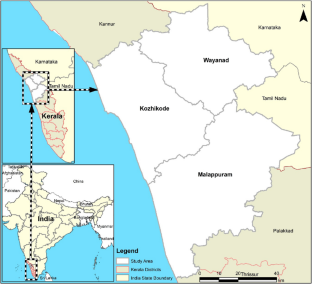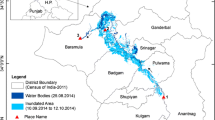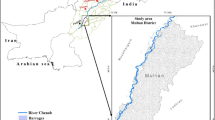Abstract
Flood mapping studies gained popularity in recent years with the availability of high-resolution SAR imagery. Satellite images in the visible spectrum cannot be used for disaster management applications due to inherent cloud cover during adverse weather conditions. The cloud penetrating capabilities and all-weather operation make radar images more suitable for flood mapping applications than optical images. The Kerala floods of 2018 were the worst disaster the state experienced in a century after the 1924 floods. It has resulted in widespread destruction and damages all around the state. Even though few flood inundation studies are based on the Kerala floods, they all concentrate on Central Kerala. Previous studies have not investigated detailed flood mapping of Northern Kerala using remote sensing techniques. This research paper explores the extent of flooding in Kozhikode, Malappuram and Wayanad districts of Northern Kerala by applying the thresholding method on radar images. The inundation extent of August 2018 is compared with the water-covered area of 2017 August to determine the extent of flooding. The current research also analyses the level of flood influence at the village level by using a spatial approach. The study reveals that the low-lying regions of the Malappuram district are the worse affected in the study area, with a few villages being severely flooded, with more than 10% of the geographical area inundated during the peak time. The flood inundation maps can be used to study the causative factors by applying modeling approaches.









Similar content being viewed by others
References
Agarwal, R. (2018). Lesson learned from killer floods in kerala: time for retrospection. Management and Economics Research Journal, 4(2), 268. https://doi.org/10.18639/MERJ.2018.04.735013
Agnihotri, A. K., et al. (2019). Flood inundation mapping and monitoring using SAR data and its impact on Ramganga River in Ganga basin. Environmental Monitoring and Assessment, 191(12), 760. https://doi.org/10.1007/s10661-019-7903-4
Anandalekshmi, A., et al. (2019). Modeling the concurrent impact of extreme rainfall and reservoir storage on Kerala floods 2018: A Copula approach. Modeling Earth Systems and Environment, 5(4), 1283–1296. https://doi.org/10.1007/s40808-019-00635-6
Anusha, N., & Bharathi, B. (2019). Change detection and flood water mapping using sentinel-1A synthetic aperture radar images. Journal of Computational and Theoretical Nanoscience, 16(8), 3544–3549. https://doi.org/10.1166/jctn.2019.8321
Arabindoo, P. (2016). Unprecedented natures? An anatomy of the Chennai floods. City, 20(6), 800–821. https://doi.org/10.1080/13604813.2016.1239410
Berezowski, T., Bielinski, T., & Osowicki, J. (2020). Flooding extent mapping for synthetic aperture radar time series using river gauge observations. IEEE Journal of Selected Topics in Applied Earth Observations and Remote Sensing, 13, 2626–2638. https://doi.org/10.1109/JSTARS.2020.2995888
Borah, S. B., et al. (2018). Flood inundation mapping and monitoring in Kaziranga National Park, Assam using Sentinel-1 SAR data. Environmental Monitoring and Assessment, 190(9), 520. https://doi.org/10.1007/s10661-018-6893-y
Census of India (2011).
Cho, C., et al. (2016). Anthropogenic footprint of climate change in the June 2013 northern India flood. Climate Dynamics, 46(3–4), 797–805. https://doi.org/10.1007/s00382-015-2613-2
Cian, F., Marconcini, M., & Ceccato, P. (2018). Normalized Difference Flood Index for rapid flood mapping: Taking advantage of EO big data. Remote Sensing of Environment, 209(March), 712–730. https://doi.org/10.1016/j.rse.2018.03.006
Clement, M. A., Kilsby, C. G., & Moore, P. (2018). Multi-temporal synthetic aperture radar flood mapping using change detection. Journal of Flood Risk Management, 11(2), 152–168. https://doi.org/10.1111/jfr3.12303
Dube, A., et al. (2014). Forecasting the heavy rainfall during Himalayan flooding—June 2013. Weather and Climate Extremes, 4, 22–34. https://doi.org/10.1016/j.wace.2014.03.004
Elhag, M., & Abdurahman, S. G. (2020). Advanced remote sensing techniques in flash flood delineation in Tabuk City, Saudi Arabia. Natural Hazards, 103(3), 3401–3413. https://doi.org/10.1007/s11069-020-04135-0
Ezzine, A., et al. (2018). Evaluation of Sentinel-1 data for flood mapping in the upstream of Sidi Salem dam (Northern Tunisia). Arabian Journal of Geosciences, 11(8), 170. https://doi.org/10.1007/s12517-018-3505-7
Ezzine, A., et al. (2020). Flood mapping using hydraulic modeling and Sentinel-1 image: Case study of Medjerda Basin, northern Tunisia. The Egyptian Journal of Remote Sensing and Space Science, 23(3), 303–310. https://doi.org/10.1016/j.ejrs.2020.03.001
Goumehei, E., et al. (2019). Surface water body detection in polarimetric sar data using contextual complex wishart classification. Water Resources Research, 55(8), 7047–7059. https://doi.org/10.1029/2019WR025192
Gupta, K. (2007). Urban flood resilience planning and management and lessons for the future: A case study of Mumbai, India. Urban Water Journal, 4(3), 183–194. https://doi.org/10.1080/15730620701464141
Hajaj, P. M. T., & Yarrakula, K. (2019). Application of synthetic aperture radar imagery for spatio-temporal assessment of flood in Nagavali River. Indian Journal of Ecology, 46(3), 521–524.
Hiep, N. Q. et al. (2019) ‘A method for constructing reservoir area-storage-elevation curve using sentinel-1 radar remote sensing image’, in 40th Asian Conference on Remote Sensing (ACRS 2019), pp. 1–10.
Hunt, K. M. R., & Menon, A. (2020). The 2018 Kerala floods: A climate change perspective. Climate Dynamics, 54(3–4), 2433–2446. https://doi.org/10.1007/s00382-020-05123-7
Iglesias, R. et al. (2018) ‘Towards Unsupervised Flood Mapping Generation Using Automatic Thresholding and Classification Aproaches’, in IGARSS 2018 - 2018 IEEE International Geoscience and Remote Sensing Symposium. IEEE, pp. 4927–4930. doi: https://doi.org/10.1109/IGARSS.2018.8519111.
Jacinth Jennifer, J., Saravanan, S., & Abijith, D. (2020). Integration of SAR and multi-spectral imagery in flood inundation mapping – a case study on Kerala floods 2018. ISH Journal of Hydraulic Engineering. https://doi.org/10.1080/09715010.2020.1791265
Jensen, J. R. (2018) Introductory Digital Image Processing: A Remote Sensing Perspective. Prentice Hall (Prentice Hall series in geographic information science). Available at: https://books.google.co.in/books?id=FvIsAQAAMAAJ.
Jones, S., et al. (2021). Landslide susceptibility investigation for Idukki district of Kerala using regression analysis and machine learning. Arabian Journal of Geosciences, 14(10), 838. https://doi.org/10.1007/s12517-021-07156-6
Joseph, J. K., et al. (2020). Community resilience mechanism in an unexpected extreme weather event: An analysis of the Kerala floods of 2018, India. International Journal of Disaster Risk Reduction, 49(June), 101741. https://doi.org/10.1016/j.ijdrr.2020.101741
Joy, J., Kanga, S., & Singh, S. K. (2019). Kerala flood 2018: Flood mapping by participatory GIS approach, Meloor Panchayat. International Journal on Emerging Technologies, 10(1), 197–205.
Kiran, K. S., Manjusree, P., & Viswanadham, M. (2019). Sentinel-1 SAR data preparation for extraction of flood footprints-A case study. Disaster Advances, 12(12), 10–20.
Kotal, S. D., Roy, S. Sen., & Bhowmik, S. K. R. (2014). Catastrophic heavy rainfall episode over Uttarakhand during 16–18 June 2013 – observational aspects. Current Science, 107(2), 234–245.
Krishna Vanama, V. S. and Rao, Y. S. (2019) ‘Change Detection Based Flood Mapping of 2015 Flood Event of Chennai City Using Sentinel-1 SAR Images’, in IGARSS 2019 - 2019 IEEE International Geoscience and Remote Sensing Symposium. IEEE, pp. 9729–9732. doi: https://doi.org/10.1109/IGARSS.2019.8899282.
Kumar, P., Rani, M., Pandey, P. C., Sajjad, H., & Chaudhary, B. S. (Eds.). (2019). Applications and challenges of geospatial technology: potential and future trends. Cham: Springer International Publishing. https://doi.org/10.1007/978-3-319-99882-4
Kuntla, S. K., & Manjusree, P. (2020). Development of an automated tool for delineation of flood footprints from sar imagery for rapid disaster response: A case study. Journal of the Indian Society of Remote Sensing, 48(6), 935–944. https://doi.org/10.1007/s12524-020-01125-4
Lal, P., et al. (2020). Evaluating the 2018 extreme flood hazard events in Kerala, India. Remote Sensing Letters, 11(5), 436–445. https://doi.org/10.1080/2150704X.2020.1730468
Liang, J., & Liu, D. (2019). (2020) ‘A local thresholding approach to flood water delineation using Sentinel-1 SAR imagery.’ ISPRS Journal of Photogrammetry and Remote Sensing, 159, 53–62. https://doi.org/10.1016/j.isprsjprs.2019.10.017
Manjusree, P., et al. (2012). Optimization of threshold ranges for rapid flood inundation mapping by evaluating backscatter profiles of high incidence angle SAR images. International Journal of Disaster Risk Science, 3(2), 113–122. https://doi.org/10.1007/s13753-012-0011-5
Martha, T. R., et al. (2015). Landslides triggered by the June 2013 extreme rainfall event in parts of Uttarakhand state, India. Landslides, 12(1), 135–146. https://doi.org/10.1007/s10346-014-0540-7
Meghanadh, D. et al. (2020) ‘Rapid flood mapping using Sentinel-1A images: A case study of flood in panamaram, Kerala’, in IGARSS 2020 - 2020 IEEE International Geoscience and Remote Sensing Symposium. IEEE, pp. 6883–6885. doi: https://doi.org/10.1109/IGARSS39084.2020.9324674.
Mehrabi, A. (2021). Monitoring the Iran Pol-e-Dokhtar flood extent and detecting its induced ground displacement using sentinel 1 imagery techniques. Natural Hazards, 105(3), 2603–2617. https://doi.org/10.1007/s11069-020-04414-w
Mishra, A. K. (2021). Observing a severe flooding over southern part of India in monsoon season of 2019. Journal of Earth System Science, 130(1), 2. https://doi.org/10.1007/s12040-020-01509-7
Mishra, A. K., & Nagaraju, V. (2019). Space-based monitoring of severe flooding of a southern state in India during south-west monsoon season of 2018. Natural Hazards, 97(2), 949–953. https://doi.org/10.1007/s11069-019-03673-6
Mishra, V., & Shah, H. L. (2018). Hydroclimatological perspective of the Kerala Flood of 2018. Journal of the Geological Society of India, 92(5), 645–650. https://doi.org/10.1007/s12594-018-1079-3
Mohammadi, A., Kamran, K. V., Karimzadeh, S., Shahabi, H., & Al-Ansari, N. (2020). Flood detection and susceptibility mapping using sentinel-1 time series, alternating decision trees, and bag-ADTree models. Complexity, 2020, 1–21. https://doi.org/10.1155/2020/4271376
Mohandas, S., et al. (2020). NWP perspective of the extreme precipitation and flood event in Kerala (India) during August 2018. Dynamics of Atmospheres and Oceans, 91(June), 101158. https://doi.org/10.1016/j.dynatmoce.2020.101158
Nagendra, N. P., Narayanamurthy, G., & Moser, R. (2020). Management of humanitarian relief operations using satellite big data analytics: The case of Kerala floods. Annals of Operations Research. https://doi.org/10.1007/s10479-020-03593-w
Neeraj, S., Mannakkara, S., & Wilkinson, S. (2021). Build back better concepts for resilient recovery: A case study of India’s 2018 flood recovery. International Journal of Disaster Resilience in the Built Environment, 12(3), 280–294. https://doi.org/10.1108/IJDRBE-05-2020-0044
Otsu, N. (1979). A threshold selection method from gray-level histograms. IEEE Transactions on Systems, Man, and Cybernetics, 9(1), 62–66. https://doi.org/10.1109/TSMC.1979.4310076
Pambudi, R. A. et al. (2020) ‘Flood Inundation Mapping of Cempaka Tropical Cyclone Effect in Gunung Sewu Karst Landscape Using Sentinel 1’, E3S Web of Conferences. Edited by B. Warsito, Sudarno, and T. Triadi Putranto, 202, p. 03030. doi: https://doi.org/10.1051/e3sconf/202020203030.
Perrou, T., Garioud, A., & Parcharidis, I. (2018). Use of Sentinel-1 imagery for flood management in a reservoir-regulated river basin. Frontiers of Earth Science, 12(3), 506–520. https://doi.org/10.1007/s11707-018-0711-2
Plank, S., et al. (2017). Mapping of flooded vegetation by means of polarimetric Sentinel-1 and ALOS-2/PALSAR-2 imagery. International Journal of Remote Sensing, 38(13), 3831–3850. https://doi.org/10.1080/01431161.2017.1306143
Prasad, A. K., & Singh, R. P. (2005). Extreme rainfall event of July 25–27, 2005 over Mumbai, West Coast, India. Journal of the Indian Society of Remote Sensing, 33(3), 365.
Rana, V. K., & Suryanarayana, T. M. (2019). Evaluation of SAR speckle filter technique for inundation mapping. Remote Sensing Applications: Society and Environment, 16(October), 100271. https://doi.org/10.1016/j.rsase.2019.100271
Ranjan, R., Sarma, H. and Saharia, N. (2018) ‘Finding out the needy one from Tweets: An analysis using #kerelafloods’, in 2018 3rd International Conference on Contemporary Computing and Informatics (IC3I). IEEE, pp. 184–187. doi: https://doi.org/10.1109/IC3I44769.2018.9007270.
Sadek, M., et al. (2020). ‘Low-cost solutions for assessment of flash flood impacts using sentinel-1/2 data fusion and hydrologic/hydraulic modeling: Wadi El-Natrun Region Egypt. Advances in Civil Engineering, 2020, 1–21. https://doi.org/10.1155/2020/1039309
Sahoo, S. N., & Sreeja, P. (2017). Development of flood inundation maps and quantification of flood risk in an urban catchment of Brahmaputra River. ASCE-ASME Journal of Risk and Uncertainty in Engineering Systems, Part a: Civil Engineering, 3(1), 1–11. https://doi.org/10.1061/AJRUA6.0000822
Samuele, D. P., Filippo, S., & Enrico, B.-M. (2021). Multi-temporal mapping of flood damage to crops using sentinel-1 imagery: A case study of the Sesia River (October 2020). Remote Sensing Letters, 12(5), 459–469. https://doi.org/10.1080/2150704X.2021.1890262
Sarkar, S., & Singh, R. P. (2017). June 19 2015 rainfall event over mumbai: some observational analysis. Journal of the Indian Society of Remote Sensing, 45(1), 185–192. https://doi.org/10.1007/s12524-016-0572-7
Schumann, G. J. P., & Moller, D. K. (2015). Microwave remote sensing of flood inundation. Physics and Chemistry of the Earth, Parts a/b/c, 83–84, 84–95. https://doi.org/10.1016/j.pce.2015.05.002
Sharifi, A. (2020). Flood mapping using relevance vector machine and sar data: a case study from Aqqala, Iran. Journal of the Indian Society of Remote Sensing, 48(9), 1289–1296. https://doi.org/10.1007/s12524-020-01155-y
Sherpa, S. F., et al. (2020). Probabilistic mapping of august 2018 flood of kerala, india, using space-borne synthetic aperture radar. IEEE Journal of Selected Topics in Applied Earth Observations and Remote Sensing, 13, 896–913. https://doi.org/10.1109/JSTARS.2020.2970337
Study report: Kerala floods of August 2018 (2018).
Sudheer, K. P., et al. (2019). Role of dams on the floods of august 2018 in Periyar River Basin, Kerala. Current Science, 116(5), 780. https://doi.org/10.18520/cs/v116/i5/780-794
Sumith, S. S. and John, C. M. (2017) ‘Analysing the capability of sentinel-1 SAR data for flood monitoring and mapping in Idukki dam Reservoir, Southern Western Ghats of India’, in 38th Asian Conference on Remote Sensing - Space Applications: Touching Human Lives, ACRS 2017, pp. 1–8.
Surampudi, S., & Yarrakula, K. (2020). Mapping and assessing spatial extent of floods from multitemporal synthetic aperture radar images: A case study on Brahmaputra River in Assam State, India. Environmental Science and Pollution Research, 27(2), 1521–1532. https://doi.org/10.1007/s11356-019-06849-6
Tavus, B., et al. (2018). Considerations on the use of sentinel-1 data in flood mapping in urban areas: Ankara (Turkey) 2018 Floods. The International Archives of the Photogrammetry, Remote Sensing and Spatial Information Sciences,. https://doi.org/10.5194/isprs-archives-XLII-5-575-2018
Thakur, P. K., et al. (2020). Synergistic use of remote sensing, GIS and hydrological models for study of august 2018 Kerala Floods. The International Archives of the Photogrammetry, Remote Sensing and Spatial Information Sciences,. https://doi.org/10.5194/isprs-archives-XLIII-B3-2020-1263-2020
Tiwari, V. et al. (2020) ‘Flood inundation mapping- Kerala 2018; Harnessing the power of SAR, automatic threshold detection method and Google Earth Engine’, PLOS ONE. Edited by G. J.-P. Schumann, 15(8), e0237324. doi: https://doi.org/10.1371/journal.pone.0237324.
Tripathi, A., Attri, L., & Tiwari, R. K. (2021). Spaceborne C-band SAR remote sensing–based flood mapping and runoff estimation for 2019 flood scenario in Rupnagar, Punjab, India. Environmental Monitoring and Assessment, 193(3), 110. https://doi.org/10.1007/s10661-021-08902-9
Tripathi, G., et al. (2020). Flood inundation mapping and impact assessment using multi-temporal optical and SAR Satellite Data: A case study of 2017 Flood in Darbhanga District, Bihar, India. Water Resources Management, 34(6), 1871–1892. https://doi.org/10.1007/s11269-020-02534-3
Twele, A., et al. (2016). Sentinel-1-based flood mapping: A fully automated processing chain. International Journal of Remote Sensing, 37(13), 2990–3004. https://doi.org/10.1080/01431161.2016.1192304
United Nations Development Programme (2018) Kerala post disaster needs assessment: Floods and landslides-August 2018. Available at: https://reliefweb.int/report/india/kerala-post-disaster-needs-assessment-floods-and-landslides-august-2018.
Vanama, V. S. K., et al. (2021a). Inundation mapping of Kerala flood event in 2018 using ALOS-2 and temporal Sentinel-1 SAR images. Current Science, 120(5), 915–925. https://doi.org/10.18520/cs/v120/i5/915-925
Vanama, V. S. K., Rao, Y. S., & Bhatt, C. M. (2021b). Change detection based flood mapping using multi-temporal Earth Observation satellite images: 2018 flood event of Kerala, India. European Journal of Remote Sensing, 54(1), 42–58. https://doi.org/10.1080/22797254.2020.1867901
Vishnu, C. L., et al. (2019). Satellite-based assessment of the August 2018 flood in parts of Kerala, India. Geomatics, Natural Hazards and Risk, 10(1), 758–767. https://doi.org/10.1080/19475705.2018.1543212
Acknowledgements
This research is undertaken as part of the DST–NRDMS project funded by the Department of Science and Technology, GOI. The authors thank the funding agency for providing the necessary guidance and financial support. We are grateful to Copernicus Open Access Hub and European Space Agency for providing Sentinel-1 data freely.
Author information
Authors and Affiliations
Corresponding author
Ethics declarations
Conflict of interest
The authors declare that there exists no conflict of interest with any individual or organization in the present work.
Additional information
Publisher's Note
Springer Nature remains neutral with regard to jurisdictional claims in published maps and institutional affiliations.
About this article
Cite this article
Chithra, K., Binoy, B.V. & Bimal, P. Spatial Mapping of the Flood-Affected Regions of Northern Kerala: A Case Study of 2018 Kerala Floods. J Indian Soc Remote Sens 50, 677–688 (2022). https://doi.org/10.1007/s12524-021-01485-5
Received:
Accepted:
Published:
Issue Date:
DOI: https://doi.org/10.1007/s12524-021-01485-5




